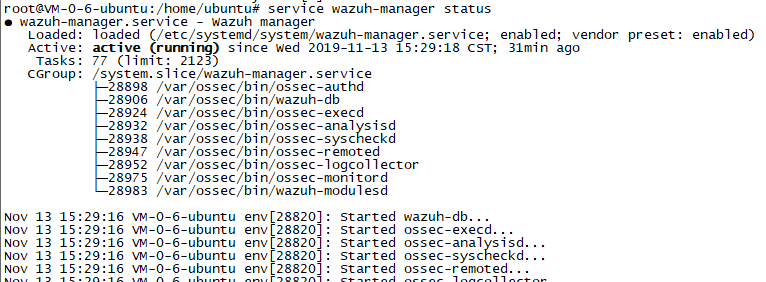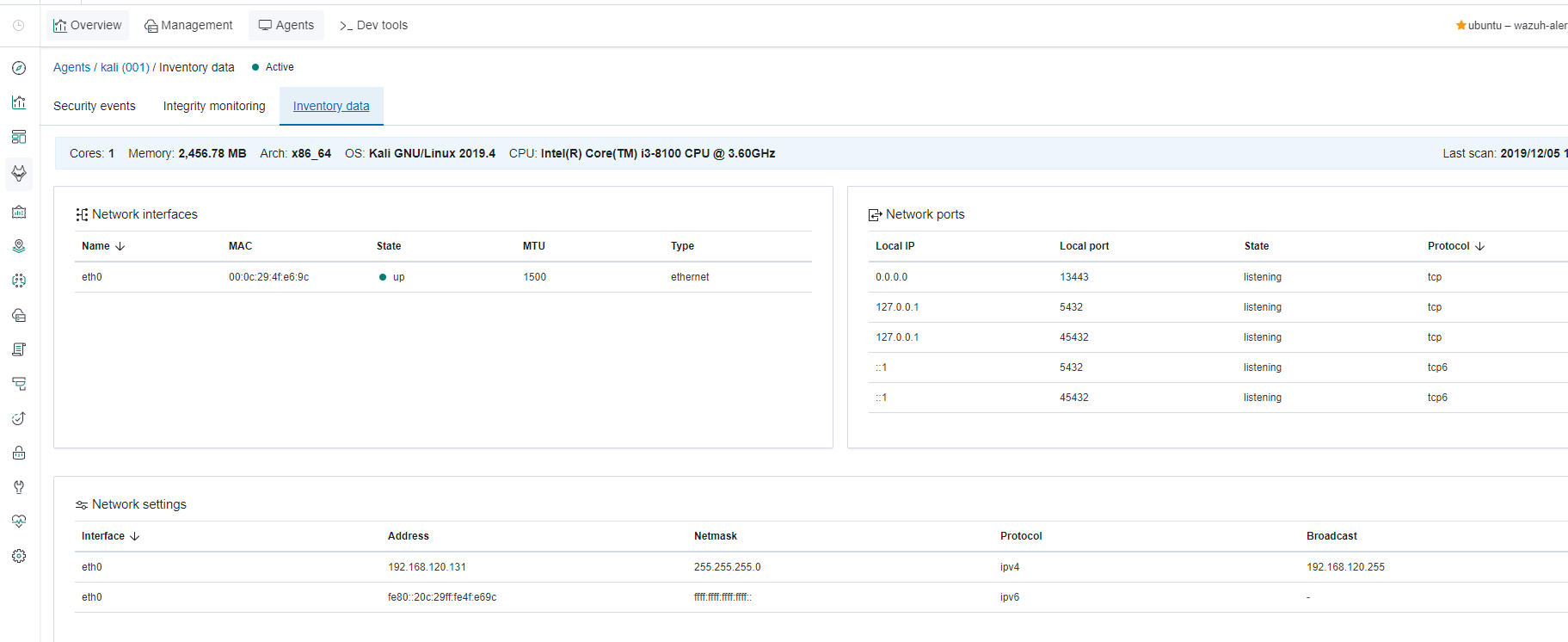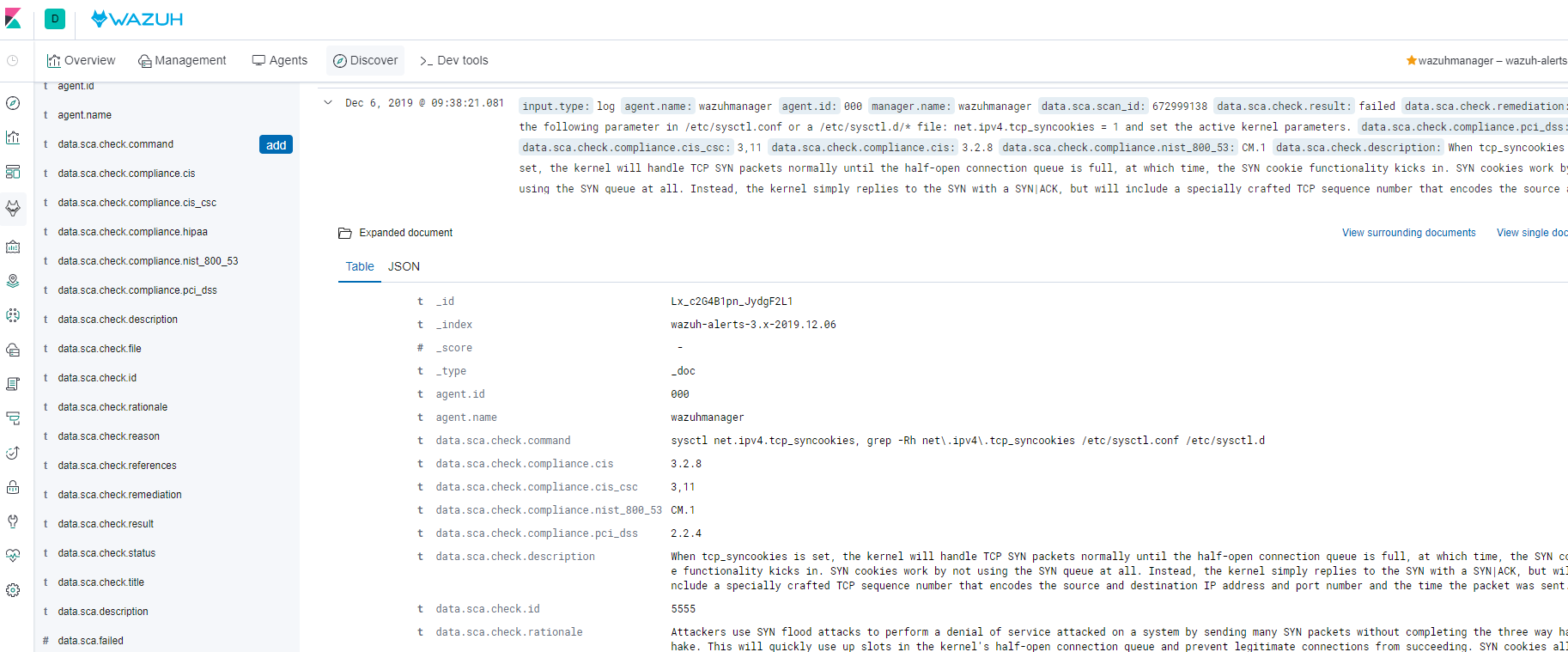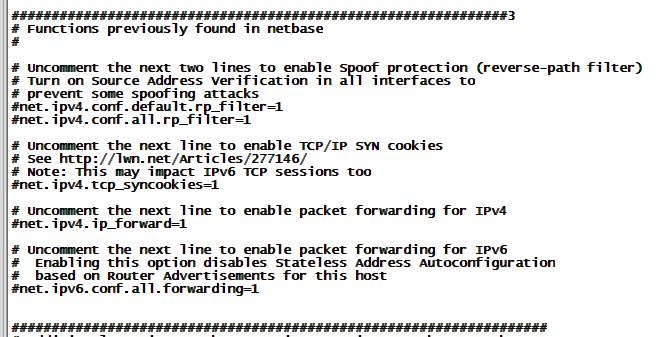安装Wazuh manager
使用Ubuntu系统,目前wazuh版本为3.10
添加更新源
apt-get update
apt-get install curl apt-transport-https lsb-release
#需要python2.7以上
curl -s https://packages.wazuh.com/key/GPG-KEY-WAZUH | apt-key add - #添加更新源
echo "deb https://packages.wazuh.com/3.x/apt/ stable main" | tee -a /etc/apt/sources.list.d/wazuh.list #更新包
apt-get update安装Wazuh Manager
apt-get install wazuh-manager
service wazuh-manager status #检查运行状态
安装Wazuh API
如果不能直接安装nodejs需要添加更新源安装
curl -sL https://deb.nodesource.com/setup_8.x | bash -
apt-get install nodejs
apt-get install wazuh-api
service wazuh-api status #检查运行状态
sed -i "s/^deb/#deb/" /etc/apt/sources.list.d/wazuh.list #禁用Wazuh更新源
apt-get update
配置API用户信息,启用HTTPS,可以使用脚本生成证书或者自动生成证书,以下自动生成证书,同时还可以修改访问API的用户,默认用户密码是foo和bar。如需要修改记得重启服务。
# 配置端口账户等信息
cd /var/ossec/api/scripts
./configure_api.sh
#不使用脚本修改
cd /var/ossec/api/configuration/auth
node htpasswd -Bc -C 10 user myUserName
安装Filebeat
Filebeat是Wazuh服务器上的工具,可以将警报和归档事件安全地转发到Elastic Stack服务器上的Logstash服务。
添加源存储库和密钥:
apt-get install curl apt-transport-https
curl -s https://artifacts.elastic.co/GPG-KEY-elasticsearch | apt-key add -
echo "deb https://artifacts.elastic.co/packages/7.x/apt stable main" | tee /etc/apt/sources.list.d/elastic-7.x.list
apt-get update安装
apt-get install filebeat=7.4.2从Wazuh存储库下载Filebeat配置文件。这是预先配置的,用于将Wazuh警报转发到Elasticsearch:
curl -so /etc/filebeat/filebeat.yml https://raw.githubusercontent.com/wazuh/wazuh/v3.10.2/extensions/filebeat/7.x/filebeat.yml下载Elasticsearch的警报模板:
curl -so /etc/filebeat/wazuh-template.json https://raw.githubusercontent.com/wazuh/wazuh/v3.10.2/extensions/elasticsearch/7.x/wazuh-template.json下载适用于Filebeat的Wazuh模块:
curl -s https://packages.wazuh.com/3.x/filebeat/wazuh-filebeat-0.1.tar.gz | sudo tar -xvz -C /usr/share/filebeat/module编辑文件,/etc/filebeat/filebeat.yml并用YOUR_ELASTIC_SERVER_IPElasticsearch服务器的IP地址或主机名替换。例如:
output.elasticsearch: hosts: ["192.168.120.128:9200"]启用并启动Filebeat服务:
systemctl daemon-reload
systemctl enable filebeat.service
systemctl start filebeat.service安装Elastic Stack
添加弹性存储库及其GPG密钥:
apt-get install curl apt-transport-https
curl -s https://artifacts.elastic.co/GPG-KEY-elasticsearch | apt-key add -
echo "deb https://artifacts.elastic.co/packages/7.x/apt stable main" | tee /etc/apt/sources.list.d/elastic-7.x.list
apt-get update安装Elasticsearch软件包:
apt-get install elasticsearch=7.4.2需要Java环境,例如安装openjdk
apt install openjdk-11-jre-headless此处网速影响,挂VPS下载软件包解压使用。
如果使用源安装编辑文件/etc/elasticsearch/elasticsearch.yml并取消注释设置,将Elasticsearch配置为侦听非回送地址network.host。将值更改为要绑定到的IP:
network.host: <elasticsearch_ip>更改network.host选项后,需要进一步配置。在文件中添加或编辑(如果有注释)以下几行/etc/elasticsearch/elasticsearch.yml:
node.name: <node_name>
cluster.initial_master_nodes: ["<node_name>"]如果使用下载文件包启动方式,编辑文件elasticsearch/config/elasticsearch.yml来执行如上操作。
修改完成后启动ES。
systemctl daemon-reload
systemctl enable elasticsearch.service
systemctl start elasticsearch.service
文件启动的话,需要非root用户启动检查启动是否正常
curl http://192.168.120.128:9200
安装Kibana
源安装
apt-get install kibana=7.4.2安装适用于Kibana的Wazuh应用程序插件:
从URL安装:
sudo -u kibana /usr/share/kibana/bin/kibana-plugin install https://packages.wazuh.com/wazuhapp/wazuhapp-3.10.2_7.4.2.zip从软件包安装:
sudo -u kibana /usr/share/kibana/bin/kibana-plugin install file:///path/wazuhapp-3.10.2_7.4.2.zip编辑文件/etc/kibana/kibana.yml,修改设置server.host
server.host: "192.168.120.128" //修改为主机地址
elasticsearch.hosts: ["http://192.168.120.128:9200"] //修改为es的主机地址,此处使用同一台主机启用并启动Kibana服务:
systemctl daemon-reload
systemctl enable kibana.service
systemctl start kibana.service禁用Elasticsearch更新:
sed -i "s/^deb/#deb/" /etc/apt/sources.list.d/elastic-7.x.list
apt-get update如果出现Kibana server is not ready yet问题,可能是kibana和es的版本不一致,尝试修改为同一版本,或者是elasticsearch.hosts没有修改为主机的IP,尝试修改为主机IP,再或者是还没刷新成功,等待一会。
选择小狐狸头像,配置API认证,如果修改了则填入设置的账号密码。

下载模版文件
# 下载filebeat配置文件
curl -so /etc/filebeat/filebeat.yml https://raw.githubusercontent.com/wazuh/wazuh/v3.9.2/extensions/filebeat/7.x/filebeat.yml
chmod go+r /etc/filebeat/filebeat.yml
# 下载elasticsearch的模版文件
curl -so /etc/filebeat/wazuh-template.json https://raw.githubusercontent.com/wazuh/wazuh/v3.9.2/extensions/elasticsearch/7.x/wazuh-template.json
chmod go+r /etc/filebeat/wazuh-template.json配置Filebeat
output.elasticsearch:
hosts: ['http://YOUR_ELASTIC_SERVER_IP:9200']
# 修改为
output.elasticsearch:
hosts: ['http://192.168.120.128:9200']安装Wazuh agent
以上安装可以在一台服务器中,此处agent则需要在需要监控的主机上安装,把agent安装到kali机中。
添加存储库
apt-get install curl apt-transport-https lsb-release gnupg2安装Wazuh存储库GPG密钥:
curl -s https://packages.wazuh.com/key/GPG-KEY-WAZUH | apt-key add -添加存储库:
echo "deb https://packages.wazuh.com/3.x/apt/ stable main" | tee /etc/apt/sources.list.d/wazuh.list更新软件包
apt-get update使用如下安装还需要配置注册,可以手动注册或者脚本注册
apt-get install wazuh-agenthttps://github.com/wazuh/wazuh-api/blob/master/examples/api-register-agent.sh
使用如下安装和部署,需要携带定义的变量,变量说明列表
https://documentation.wazuh.com/3.10/user-manual/registering/index.html#register-agents
WAZUH_MANAGER="192.168.120.128" apt-get install wazuh-agent //wazuh-api地址,多个服务使用逗号分隔或者下载软件包安装,使用脚本注册
https://packages.wazuh.com/3.x/apt/pool/main/w/wazuh-agent/wazuh-agent_3.10.2-1_amd64.deb
#!/bin/bash
###
# Shell script for registering agents automatically with the API
# Copyright (C) 2017 Wazuh, Inc. All rights reserved.
# Wazuh.com
#
# This program is a free software; you can redistribute it
# and/or modify it under the terms of the GNU General Public
# License (version 2) as published by the FSF - Free Software
# Foundation.
###
# Connection variables
API_IP="192.168.120.128" #wazuh-api 地址
API_PORT="55000"
PROTOCOL="http"
USER="qweasd"
PASSWORD="qweasd"
display_help() {
cat <<HELP_USAGE
$0 [-h] [-f|--force] [-q|--quiet] [agent]
-h Show this message.
-f|--force Force agent removal (if already registered)
The agent will be re-regitered with a new ID
-s|--silent Surpress the output while removing the agent
agent Agent name (if missing we will use the output
of the hostname command)
HELP_USAGE
}
register_agent() {
# Adding agent and getting Id from manager
echo ""
echo "Adding agent:"
echo "curl -s -u $USER:**** -k -X POST -d 'name=$AGENT_NAME' $PROTOCOL://$API_IP:$API_PORT/agents"
API_RESULT=$(curl -s -u $USER:"$PASSWORD" -k -X POST -d 'name='$AGENT_NAME $PROTOCOL://$API_IP:$API_PORT/agents)
echo -e $API_RESULT | grep -q "\"error\":0" 2>&1
if [ "$?" != "0" ]; then
echo -e $API_RESULT | sed -rn 's/.*"message":"(.+)".*/\1/p'
exit 1
fi
# Get agent id and agent key
AGENT_ID=$(echo $API_RESULT | cut -d':' -f 4 | cut -d ',' -f 1)
AGENT_KEY=$(echo $API_RESULT | cut -d':' -f 5 | cut -d '}' -f 1)
echo "Agent '$AGENT_NAME' with ID '$AGENT_ID' added."
echo "Key for agent '$AGENT_ID' received."
# Importing key
echo ""
echo "Importing authentication key:"
echo "y" | /var/ossec/bin/manage_agents -i $AGENT_KEY
# Restarting agent
echo ""
echo "Restarting:"
echo ""
/var/ossec/bin/ossec-control restart
exit 0
}
remove_agent() {
echo "Found: $AGENT_ID"
echo "Removing previous registration for '$AGENT_NAME' using ID: $AGENT_ID ..."
# curl -u foo:bar -k -X DELETE "https://127.0.0.1:55000/agents/001
REMOVE_AGENT=$(curl -s -u $USER:"$PASSWORD" -k -X DELETE $PROTOCOL://$API_IP:$API_PORT/agents/$AGENT_ID)
echo -e $REMOVE_AGENT
}
get_agent_id() {
echo ""
echo "Checking for Agent ID..."
AGENT_ID=$(curl -s -u $USER:"$PASSWORD" -k -X GET $PROTOCOL://$API_IP:$API_PORT/agents/name/$AGENT_NAME | rev | cut -d: -f1 | rev | grep -o '".*"' | tr -d '"')
}
# MAIN
# ENTRY POINT
while getopts ':hfs' OPTION; do
case "$OPTION" in
h)
display_help
exit 0
;;
f|--force)
FORCE=true
;;
s|--silent)
SILENT=true
;;
esac
done
# reset $1, $2 .... as normal argument after the flag
shift $(($OPTIND - 1))
# if no arguments are passed in after the flags, we assign the hostname value to the AGENT_NAME
AGENT_NAME=${1:-$(hostname)}
get_agent_id
# check the return value. If we get an integer back then the agent is already registered. Anything else -> agent is not registered
if ! [ "$AGENT_ID" -eq "$AGENT_ID" ] 2> /dev/null ; then
echo "Starting registration process ..."
:
elif [[ "$FORCE" = true && "$SILENT" = "true" ]] ; then
remove_agent > /dev/null 2>&1
else
if [[ "$FORCE" = true ]] ; then
remove_agent
fi
fi
# Default action -> try to register the agent
register_agent配置好后,访问wazuh界面中的agent就可以看到连接状态了

在Inventory data中可以看到主机的网卡,网络连接,软件包等信息。

配置文件 /var/ossec/etc/ossec.conf文件完成性监控,同时需要修改server端的获取时间和配置
<frequency>43200</frequency> #默认为十二小时,此处修改为100秒
<!-- File integrity monitoring -->
<syscheck>
<disabled>no</disabled> #文件完整性监控,默认为no
<syscheck>
<directories check_all="yes" realtime="yes">/tmp</directories> #实时扫描,仅使用目录
</syscheck>
<syscheck>
<frequency>36000</frequency> #计划扫描,每十小时一次
<directories>/etc,/usr/bin,/usr/sbin</directories> #计划扫描的目录
<directories>/bin,/sbin</directories>
</syscheck>
<syscheck> #包含了实时扫描,同时带有who-data信息
<directories check_all="yes" whodata="yes">/etc</directories>
</syscheck>
<rule id="100345" level="12"> #基于规则检测报警,规则id来自Management/Ruleset
<if_group>syscheck</if_group>
<match>/var/www/htdocs</match>
<description>Changes to /var/www/htdocs - Critical file!</description>
</rule>
<directories check_all="yes">/etc,/usr/bin,/usr/sbin</directories> #要检查的目录(执行所有可能的验证)
<ignore>/etc/mtab</ignore> #要忽略的目录
如果启用了whodata字段,需要执行以下安装
apt install auditd
auditctl -l | grep wazuh_fim #检查是否应用了用于监视所选文件夹的审核规则:-w /etc -p wa -k wazuh_fim命令监控,必须将代理显式配置为接受远程命令,文件/var/ossec/etc/local_internal_options.conf
logcollector.remote_commands=1根据文档建议,修改/var/ossec/etc/shared/agent.conf文件,如果包含多个组文件夹,需要到每个组文件夹下修改配置文件,name,os,profile是可以设置。
<agent_config name="agent_name">
<localfile>
<location>/var/log/my.log</location>
<log_format>syslog</log_format>
</localfile>
</agent_config>
<agent_config os="Linux">
<localfile>
<location>/var/log/linux.log</location>
<log_format>syslog</log_format>
</localfile>
</agent_config>
<agent_config profile="database">
<localfile>
<location>/var/log/database.log</location>
<log_format>syslog</log_format>
</localfile>
</agent_config>
<agent_config name="kali">
<localfile>
<log_format>command</log_format> #command 指逐行读取
<command>df -P</command>
</localfile>
<localfile>
<log_format>full_command</log_format> #全部匹配查找
<command>netstat -tan |grep LISTEN |egrep -v '(127.0.0.1| ::1)' | sort</command>
</localfile>
</agent_config>
漏洞检测,需要配置agent端和server端/var/ossec/etc/ossec.conf
agent端
<wodle name="syscollector">
<disabled>no</disabled>
<interval>1h</interval>
<packages>yes</packages>
</wodle>
server端
<wodle name="vulnerability-detector">
<disabled>no</disabled>
<interval>5m</interval>
<run_on_start>yes</run_on_start>
<feed name="ubuntu-18">
<disabled>no</disabled>
<update_interval>1h</update_interval>
</feed>
</wodle>
systemctl restart wazuh-manager #重启虚拟机
当然,如果觉得以上安装过于繁琐,可以选择虚拟机安装一个wazuh服务端,仅在64位系统中运行。不建议在生产中直接使用。
https://packages.wazuh.com/vm/wazuh3.10.2_7.3.2.ova
root密码为wazh,api密码为默认的foo/bar。
安装的Elasticsearch /usr/share/elasticsearch。Filebeat安装在中/usr/share/filebeat,其配置文件位于中/etc/filebeat/filebeat.yml。
启动服务和重启相关服务
systemctl restart wazuh-manager
systemctl restart wazuh-api
systemctl stop elasticsearch
systemctl start filebeat
systemctl status kibanakibana地址为https://IP,在如下界面中即可看到wazuh做的相关配置检查,和建议。此建议开启tcp_syncookies来处理DOS攻击中的SYN握手的资源消耗。

根据配置文件查看对应配置是否开启,配置默认关闭,根据需求来判断是否开启。
